Organisational Change and Cultures: Leadership and Change Report
VerifiedAdded on 2022/11/24
|20
|5116
|1
Report
AI Summary
This report delves into the complexities of organizational change and its impact on educational settings. It explores various leadership attributes, including servant leadership and transformational leadership, and their effectiveness in tackling educational inequalities. The report examines Lewin's Change Theory, outlining the stages of unfreezing, change, and refreezing, along with the forces of propulsion and resistance. It further discusses organizational strategies for addressing educational inequalities, focusing on leadership capacity building, engagement of senior leaders, and the development of future leaders. The report emphasizes the importance of adapting school culture, policies, and practices to promote student learning and highlights the significance of leadership in driving and managing change within educational institutions. It also touches upon the role of distributed leadership and self-development in fostering effective organizational change.
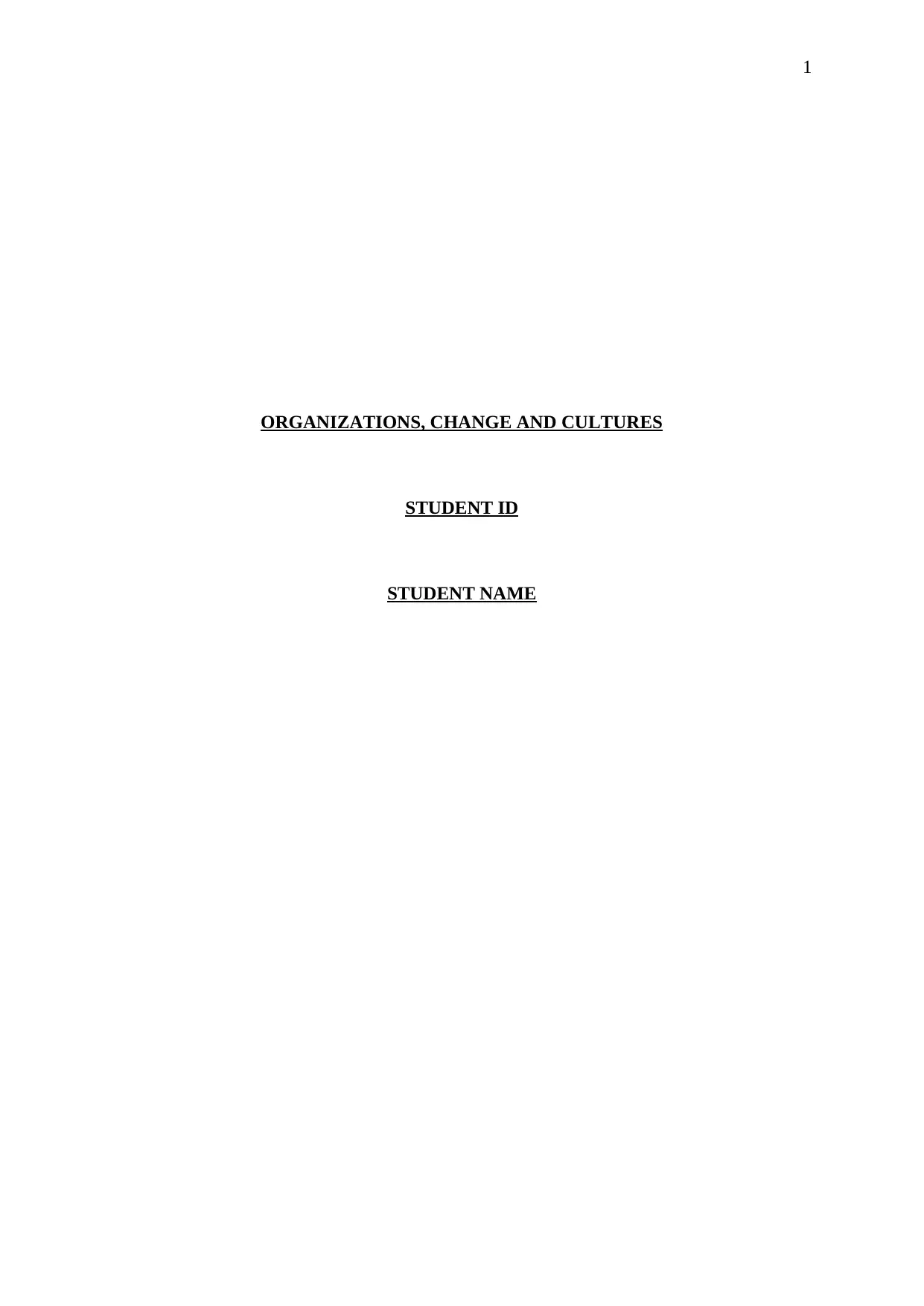
1
ORGANIZATIONS, CHANGE AND CULTURES
STUDENT ID
STUDENT NAME
ORGANIZATIONS, CHANGE AND CULTURES
STUDENT ID
STUDENT NAME
Paraphrase This Document
Need a fresh take? Get an instant paraphrase of this document with our AI Paraphraser
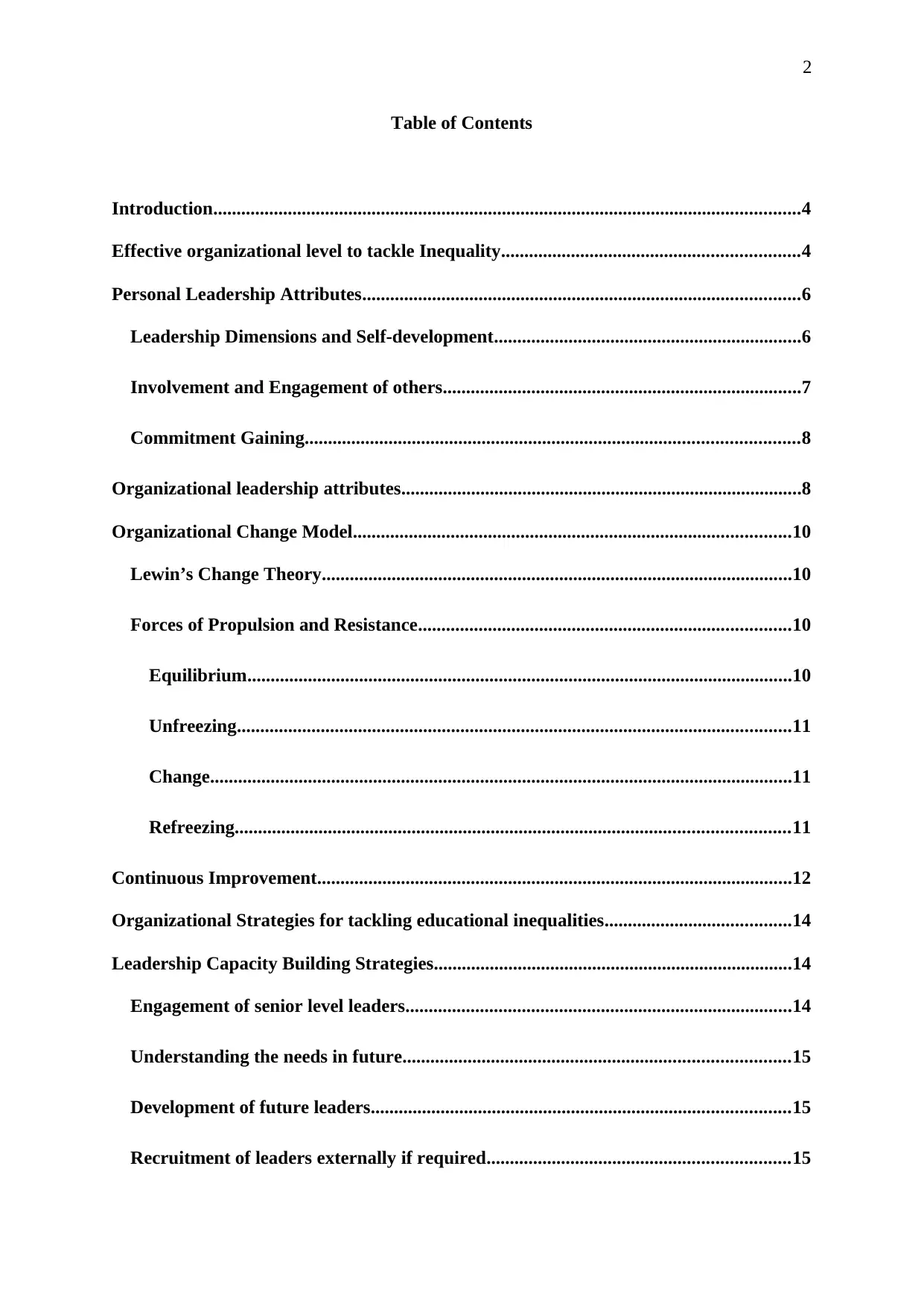
2
Table of Contents
Introduction..............................................................................................................................4
Effective organizational level to tackle Inequality................................................................4
Personal Leadership Attributes..............................................................................................6
Leadership Dimensions and Self-development..................................................................6
Involvement and Engagement of others.............................................................................7
Commitment Gaining..........................................................................................................8
Organizational leadership attributes......................................................................................8
Organizational Change Model..............................................................................................10
Lewin’s Change Theory.....................................................................................................10
Forces of Propulsion and Resistance................................................................................10
Equilibrium.....................................................................................................................10
Unfreezing.......................................................................................................................11
Change.............................................................................................................................11
Refreezing.......................................................................................................................11
Continuous Improvement......................................................................................................12
Organizational Strategies for tackling educational inequalities........................................14
Leadership Capacity Building Strategies.............................................................................14
Engagement of senior level leaders...................................................................................14
Understanding the needs in future...................................................................................15
Development of future leaders..........................................................................................15
Recruitment of leaders externally if required.................................................................15
Table of Contents
Introduction..............................................................................................................................4
Effective organizational level to tackle Inequality................................................................4
Personal Leadership Attributes..............................................................................................6
Leadership Dimensions and Self-development..................................................................6
Involvement and Engagement of others.............................................................................7
Commitment Gaining..........................................................................................................8
Organizational leadership attributes......................................................................................8
Organizational Change Model..............................................................................................10
Lewin’s Change Theory.....................................................................................................10
Forces of Propulsion and Resistance................................................................................10
Equilibrium.....................................................................................................................10
Unfreezing.......................................................................................................................11
Change.............................................................................................................................11
Refreezing.......................................................................................................................11
Continuous Improvement......................................................................................................12
Organizational Strategies for tackling educational inequalities........................................14
Leadership Capacity Building Strategies.............................................................................14
Engagement of senior level leaders...................................................................................14
Understanding the needs in future...................................................................................15
Development of future leaders..........................................................................................15
Recruitment of leaders externally if required.................................................................15
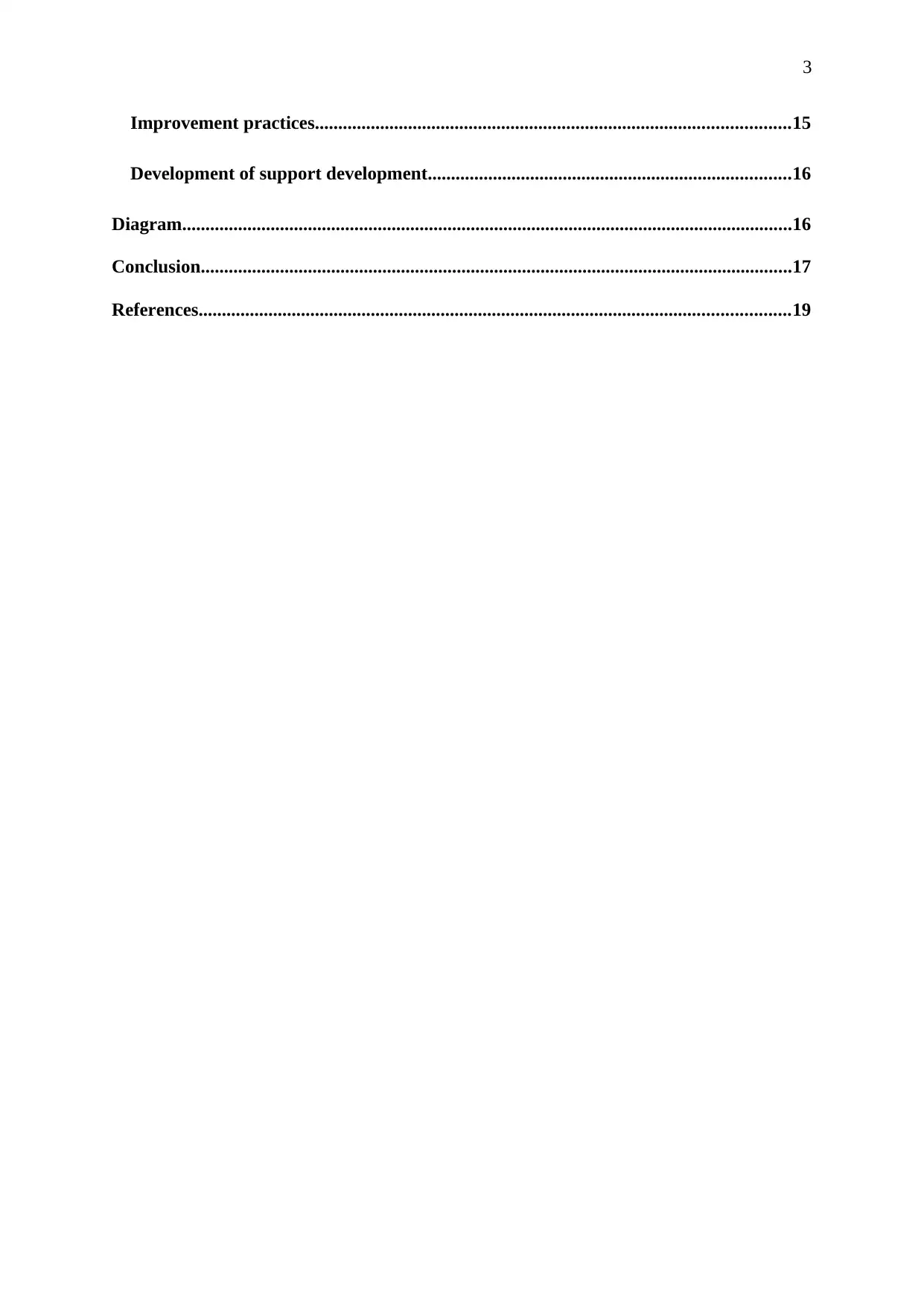
3
Improvement practices......................................................................................................15
Development of support development..............................................................................16
Diagram...................................................................................................................................16
Conclusion...............................................................................................................................17
References...............................................................................................................................19
Improvement practices......................................................................................................15
Development of support development..............................................................................16
Diagram...................................................................................................................................16
Conclusion...............................................................................................................................17
References...............................................................................................................................19
⊘ This is a preview!⊘
Do you want full access?
Subscribe today to unlock all pages.

Trusted by 1+ million students worldwide
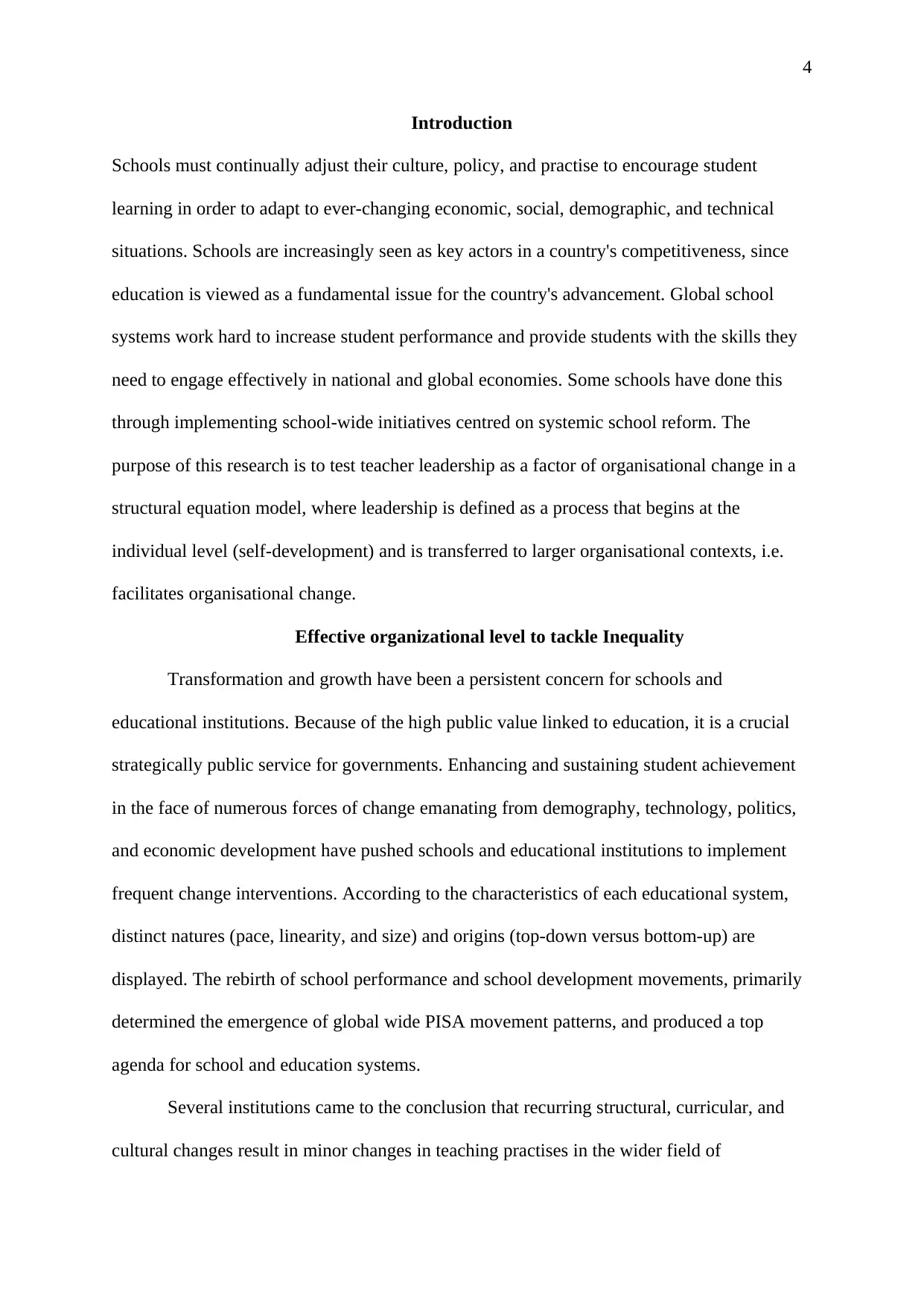
4
Introduction
Schools must continually adjust their culture, policy, and practise to encourage student
learning in order to adapt to ever-changing economic, social, demographic, and technical
situations. Schools are increasingly seen as key actors in a country's competitiveness, since
education is viewed as a fundamental issue for the country's advancement. Global school
systems work hard to increase student performance and provide students with the skills they
need to engage effectively in national and global economies. Some schools have done this
through implementing school-wide initiatives centred on systemic school reform. The
purpose of this research is to test teacher leadership as a factor of organisational change in a
structural equation model, where leadership is defined as a process that begins at the
individual level (self-development) and is transferred to larger organisational contexts, i.e.
facilitates organisational change.
Effective organizational level to tackle Inequality
Transformation and growth have been a persistent concern for schools and
educational institutions. Because of the high public value linked to education, it is a crucial
strategically public service for governments. Enhancing and sustaining student achievement
in the face of numerous forces of change emanating from demography, technology, politics,
and economic development have pushed schools and educational institutions to implement
frequent change interventions. According to the characteristics of each educational system,
distinct natures (pace, linearity, and size) and origins (top-down versus bottom-up) are
displayed. The rebirth of school performance and school development movements, primarily
determined the emergence of global wide PISA movement patterns, and produced a top
agenda for school and education systems.
Several institutions came to the conclusion that recurring structural, curricular, and
cultural changes result in minor changes in teaching practises in the wider field of
Introduction
Schools must continually adjust their culture, policy, and practise to encourage student
learning in order to adapt to ever-changing economic, social, demographic, and technical
situations. Schools are increasingly seen as key actors in a country's competitiveness, since
education is viewed as a fundamental issue for the country's advancement. Global school
systems work hard to increase student performance and provide students with the skills they
need to engage effectively in national and global economies. Some schools have done this
through implementing school-wide initiatives centred on systemic school reform. The
purpose of this research is to test teacher leadership as a factor of organisational change in a
structural equation model, where leadership is defined as a process that begins at the
individual level (self-development) and is transferred to larger organisational contexts, i.e.
facilitates organisational change.
Effective organizational level to tackle Inequality
Transformation and growth have been a persistent concern for schools and
educational institutions. Because of the high public value linked to education, it is a crucial
strategically public service for governments. Enhancing and sustaining student achievement
in the face of numerous forces of change emanating from demography, technology, politics,
and economic development have pushed schools and educational institutions to implement
frequent change interventions. According to the characteristics of each educational system,
distinct natures (pace, linearity, and size) and origins (top-down versus bottom-up) are
displayed. The rebirth of school performance and school development movements, primarily
determined the emergence of global wide PISA movement patterns, and produced a top
agenda for school and education systems.
Several institutions came to the conclusion that recurring structural, curricular, and
cultural changes result in minor changes in teaching practises in the wider field of
Paraphrase This Document
Need a fresh take? Get an instant paraphrase of this document with our AI Paraphraser
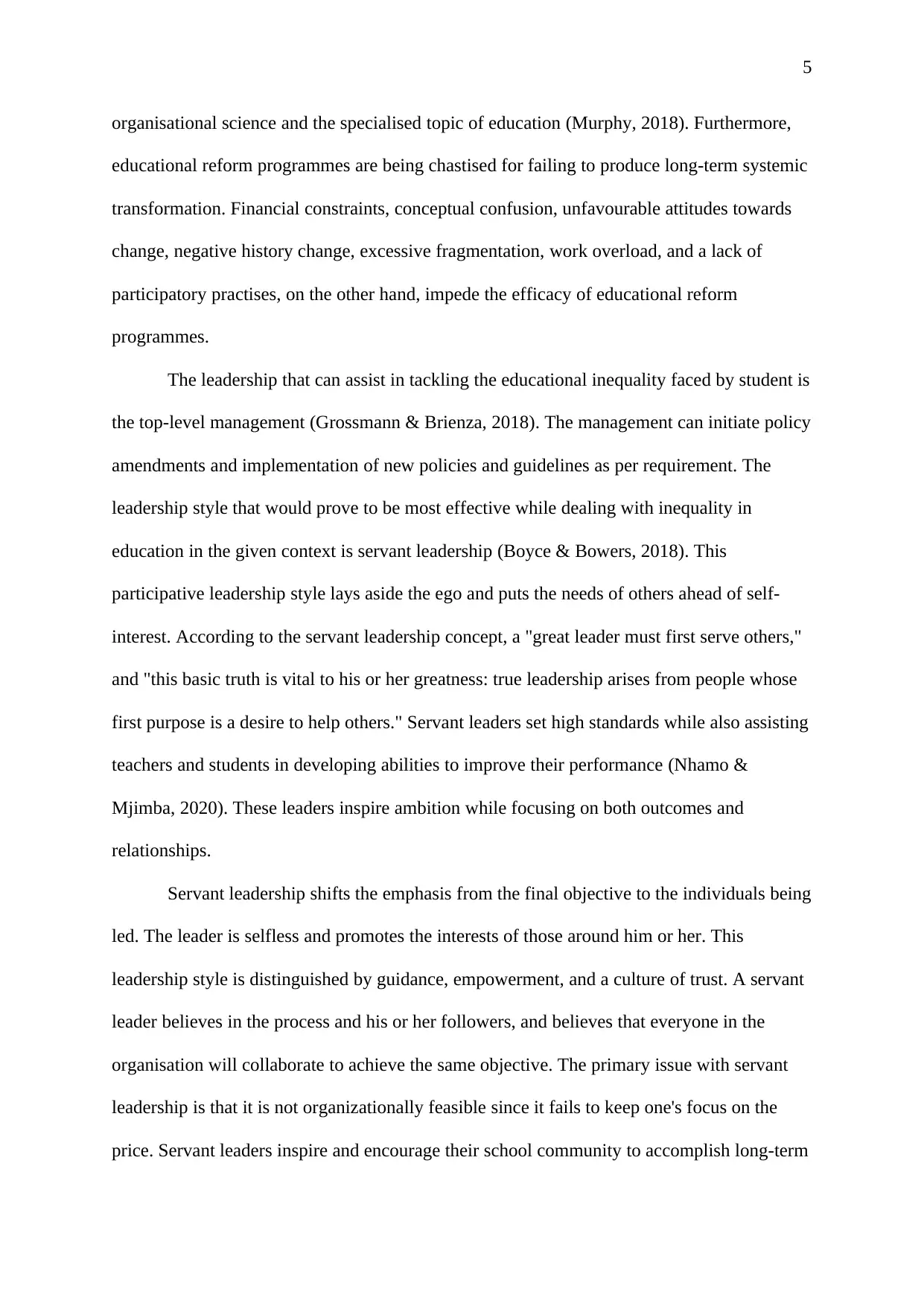
5
organisational science and the specialised topic of education (Murphy, 2018). Furthermore,
educational reform programmes are being chastised for failing to produce long-term systemic
transformation. Financial constraints, conceptual confusion, unfavourable attitudes towards
change, negative history change, excessive fragmentation, work overload, and a lack of
participatory practises, on the other hand, impede the efficacy of educational reform
programmes.
The leadership that can assist in tackling the educational inequality faced by student is
the top-level management (Grossmann & Brienza, 2018). The management can initiate policy
amendments and implementation of new policies and guidelines as per requirement. The
leadership style that would prove to be most effective while dealing with inequality in
education in the given context is servant leadership (Boyce & Bowers, 2018). This
participative leadership style lays aside the ego and puts the needs of others ahead of self-
interest. According to the servant leadership concept, a "great leader must first serve others,"
and "this basic truth is vital to his or her greatness: true leadership arises from people whose
first purpose is a desire to help others." Servant leaders set high standards while also assisting
teachers and students in developing abilities to improve their performance (Nhamo &
Mjimba, 2020). These leaders inspire ambition while focusing on both outcomes and
relationships.
Servant leadership shifts the emphasis from the final objective to the individuals being
led. The leader is selfless and promotes the interests of those around him or her. This
leadership style is distinguished by guidance, empowerment, and a culture of trust. A servant
leader believes in the process and his or her followers, and believes that everyone in the
organisation will collaborate to achieve the same objective. The primary issue with servant
leadership is that it is not organizationally feasible since it fails to keep one's focus on the
price. Servant leaders inspire and encourage their school community to accomplish long-term
organisational science and the specialised topic of education (Murphy, 2018). Furthermore,
educational reform programmes are being chastised for failing to produce long-term systemic
transformation. Financial constraints, conceptual confusion, unfavourable attitudes towards
change, negative history change, excessive fragmentation, work overload, and a lack of
participatory practises, on the other hand, impede the efficacy of educational reform
programmes.
The leadership that can assist in tackling the educational inequality faced by student is
the top-level management (Grossmann & Brienza, 2018). The management can initiate policy
amendments and implementation of new policies and guidelines as per requirement. The
leadership style that would prove to be most effective while dealing with inequality in
education in the given context is servant leadership (Boyce & Bowers, 2018). This
participative leadership style lays aside the ego and puts the needs of others ahead of self-
interest. According to the servant leadership concept, a "great leader must first serve others,"
and "this basic truth is vital to his or her greatness: true leadership arises from people whose
first purpose is a desire to help others." Servant leaders set high standards while also assisting
teachers and students in developing abilities to improve their performance (Nhamo &
Mjimba, 2020). These leaders inspire ambition while focusing on both outcomes and
relationships.
Servant leadership shifts the emphasis from the final objective to the individuals being
led. The leader is selfless and promotes the interests of those around him or her. This
leadership style is distinguished by guidance, empowerment, and a culture of trust. A servant
leader believes in the process and his or her followers, and believes that everyone in the
organisation will collaborate to achieve the same objective. The primary issue with servant
leadership is that it is not organizationally feasible since it fails to keep one's focus on the
price. Servant leaders inspire and encourage their school community to accomplish long-term
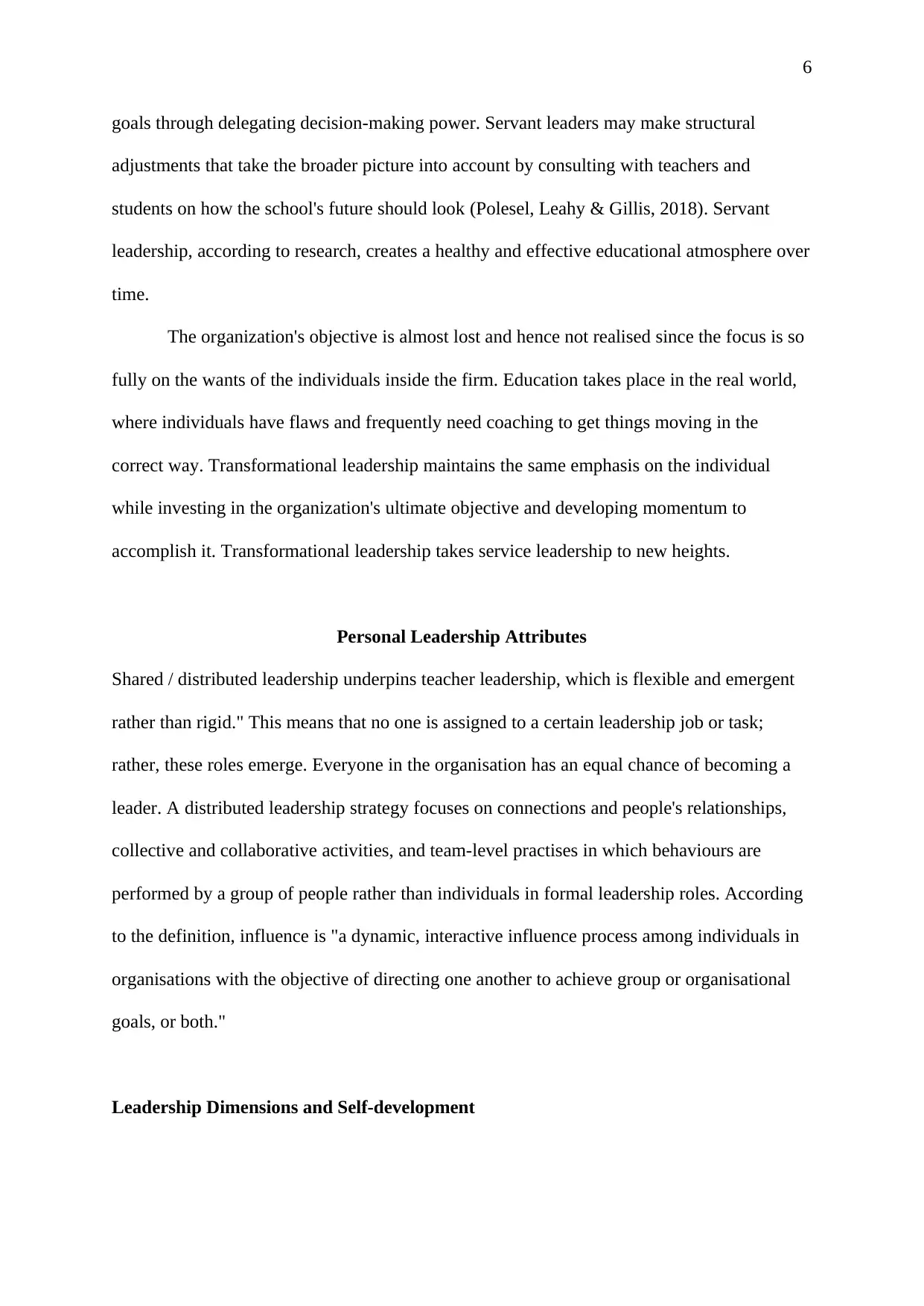
6
goals through delegating decision-making power. Servant leaders may make structural
adjustments that take the broader picture into account by consulting with teachers and
students on how the school's future should look (Polesel, Leahy & Gillis, 2018). Servant
leadership, according to research, creates a healthy and effective educational atmosphere over
time.
The organization's objective is almost lost and hence not realised since the focus is so
fully on the wants of the individuals inside the firm. Education takes place in the real world,
where individuals have flaws and frequently need coaching to get things moving in the
correct way. Transformational leadership maintains the same emphasis on the individual
while investing in the organization's ultimate objective and developing momentum to
accomplish it. Transformational leadership takes service leadership to new heights.
Personal Leadership Attributes
Shared / distributed leadership underpins teacher leadership, which is flexible and emergent
rather than rigid." This means that no one is assigned to a certain leadership job or task;
rather, these roles emerge. Everyone in the organisation has an equal chance of becoming a
leader. A distributed leadership strategy focuses on connections and people's relationships,
collective and collaborative activities, and team-level practises in which behaviours are
performed by a group of people rather than individuals in formal leadership roles. According
to the definition, influence is "a dynamic, interactive influence process among individuals in
organisations with the objective of directing one another to achieve group or organisational
goals, or both."
Leadership Dimensions and Self-development
goals through delegating decision-making power. Servant leaders may make structural
adjustments that take the broader picture into account by consulting with teachers and
students on how the school's future should look (Polesel, Leahy & Gillis, 2018). Servant
leadership, according to research, creates a healthy and effective educational atmosphere over
time.
The organization's objective is almost lost and hence not realised since the focus is so
fully on the wants of the individuals inside the firm. Education takes place in the real world,
where individuals have flaws and frequently need coaching to get things moving in the
correct way. Transformational leadership maintains the same emphasis on the individual
while investing in the organization's ultimate objective and developing momentum to
accomplish it. Transformational leadership takes service leadership to new heights.
Personal Leadership Attributes
Shared / distributed leadership underpins teacher leadership, which is flexible and emergent
rather than rigid." This means that no one is assigned to a certain leadership job or task;
rather, these roles emerge. Everyone in the organisation has an equal chance of becoming a
leader. A distributed leadership strategy focuses on connections and people's relationships,
collective and collaborative activities, and team-level practises in which behaviours are
performed by a group of people rather than individuals in formal leadership roles. According
to the definition, influence is "a dynamic, interactive influence process among individuals in
organisations with the objective of directing one another to achieve group or organisational
goals, or both."
Leadership Dimensions and Self-development
⊘ This is a preview!⊘
Do you want full access?
Subscribe today to unlock all pages.

Trusted by 1+ million students worldwide
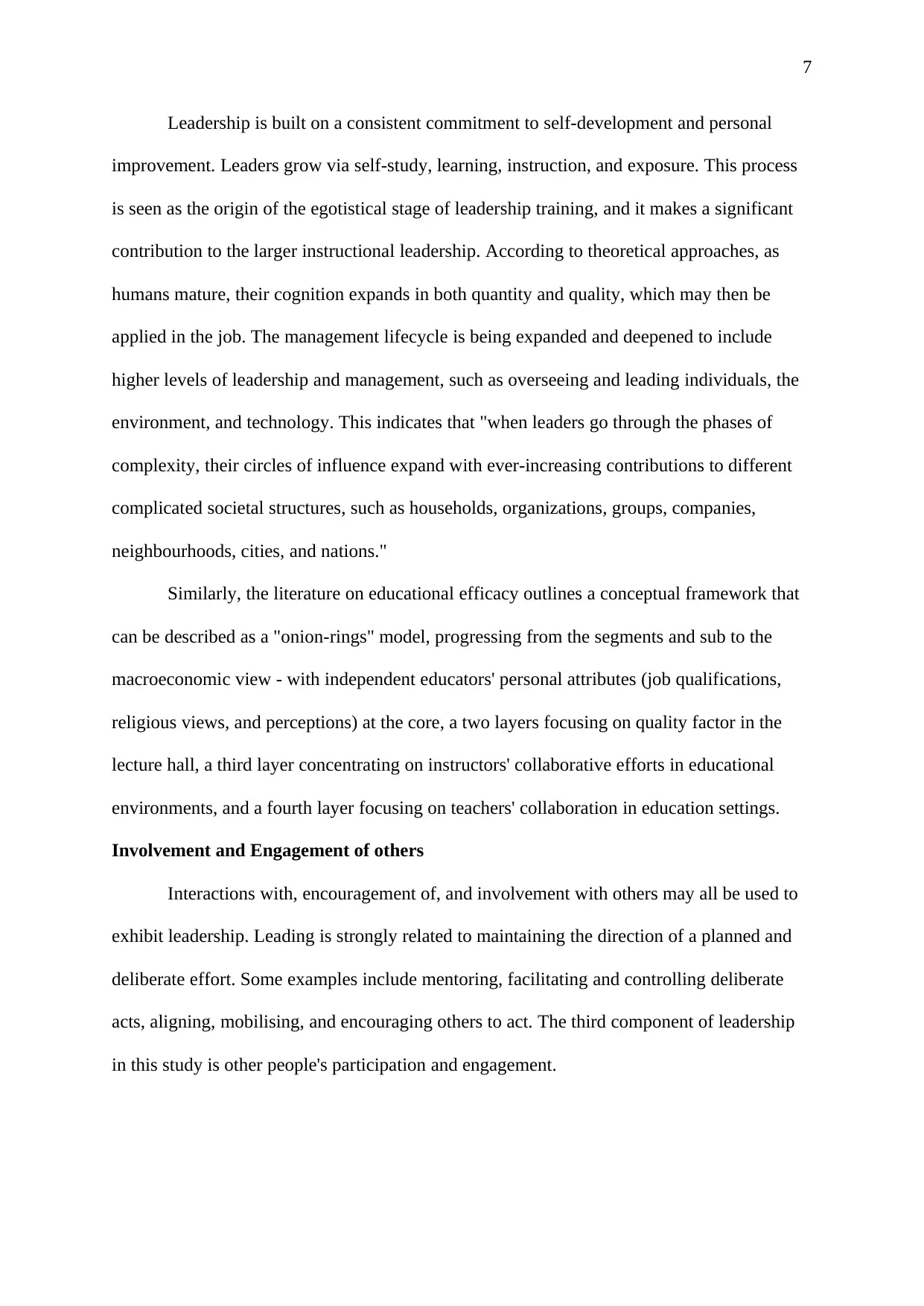
7
Leadership is built on a consistent commitment to self-development and personal
improvement. Leaders grow via self-study, learning, instruction, and exposure. This process
is seen as the origin of the egotistical stage of leadership training, and it makes a significant
contribution to the larger instructional leadership. According to theoretical approaches, as
humans mature, their cognition expands in both quantity and quality, which may then be
applied in the job. The management lifecycle is being expanded and deepened to include
higher levels of leadership and management, such as overseeing and leading individuals, the
environment, and technology. This indicates that "when leaders go through the phases of
complexity, their circles of influence expand with ever-increasing contributions to different
complicated societal structures, such as households, organizations, groups, companies,
neighbourhoods, cities, and nations."
Similarly, the literature on educational efficacy outlines a conceptual framework that
can be described as a "onion-rings" model, progressing from the segments and sub to the
macroeconomic view - with independent educators' personal attributes (job qualifications,
religious views, and perceptions) at the core, a two layers focusing on quality factor in the
lecture hall, a third layer concentrating on instructors' collaborative efforts in educational
environments, and a fourth layer focusing on teachers' collaboration in education settings.
Involvement and Engagement of others
Interactions with, encouragement of, and involvement with others may all be used to
exhibit leadership. Leading is strongly related to maintaining the direction of a planned and
deliberate effort. Some examples include mentoring, facilitating and controlling deliberate
acts, aligning, mobilising, and encouraging others to act. The third component of leadership
in this study is other people's participation and engagement.
Leadership is built on a consistent commitment to self-development and personal
improvement. Leaders grow via self-study, learning, instruction, and exposure. This process
is seen as the origin of the egotistical stage of leadership training, and it makes a significant
contribution to the larger instructional leadership. According to theoretical approaches, as
humans mature, their cognition expands in both quantity and quality, which may then be
applied in the job. The management lifecycle is being expanded and deepened to include
higher levels of leadership and management, such as overseeing and leading individuals, the
environment, and technology. This indicates that "when leaders go through the phases of
complexity, their circles of influence expand with ever-increasing contributions to different
complicated societal structures, such as households, organizations, groups, companies,
neighbourhoods, cities, and nations."
Similarly, the literature on educational efficacy outlines a conceptual framework that
can be described as a "onion-rings" model, progressing from the segments and sub to the
macroeconomic view - with independent educators' personal attributes (job qualifications,
religious views, and perceptions) at the core, a two layers focusing on quality factor in the
lecture hall, a third layer concentrating on instructors' collaborative efforts in educational
environments, and a fourth layer focusing on teachers' collaboration in education settings.
Involvement and Engagement of others
Interactions with, encouragement of, and involvement with others may all be used to
exhibit leadership. Leading is strongly related to maintaining the direction of a planned and
deliberate effort. Some examples include mentoring, facilitating and controlling deliberate
acts, aligning, mobilising, and encouraging others to act. The third component of leadership
in this study is other people's participation and engagement.
Paraphrase This Document
Need a fresh take? Get an instant paraphrase of this document with our AI Paraphraser
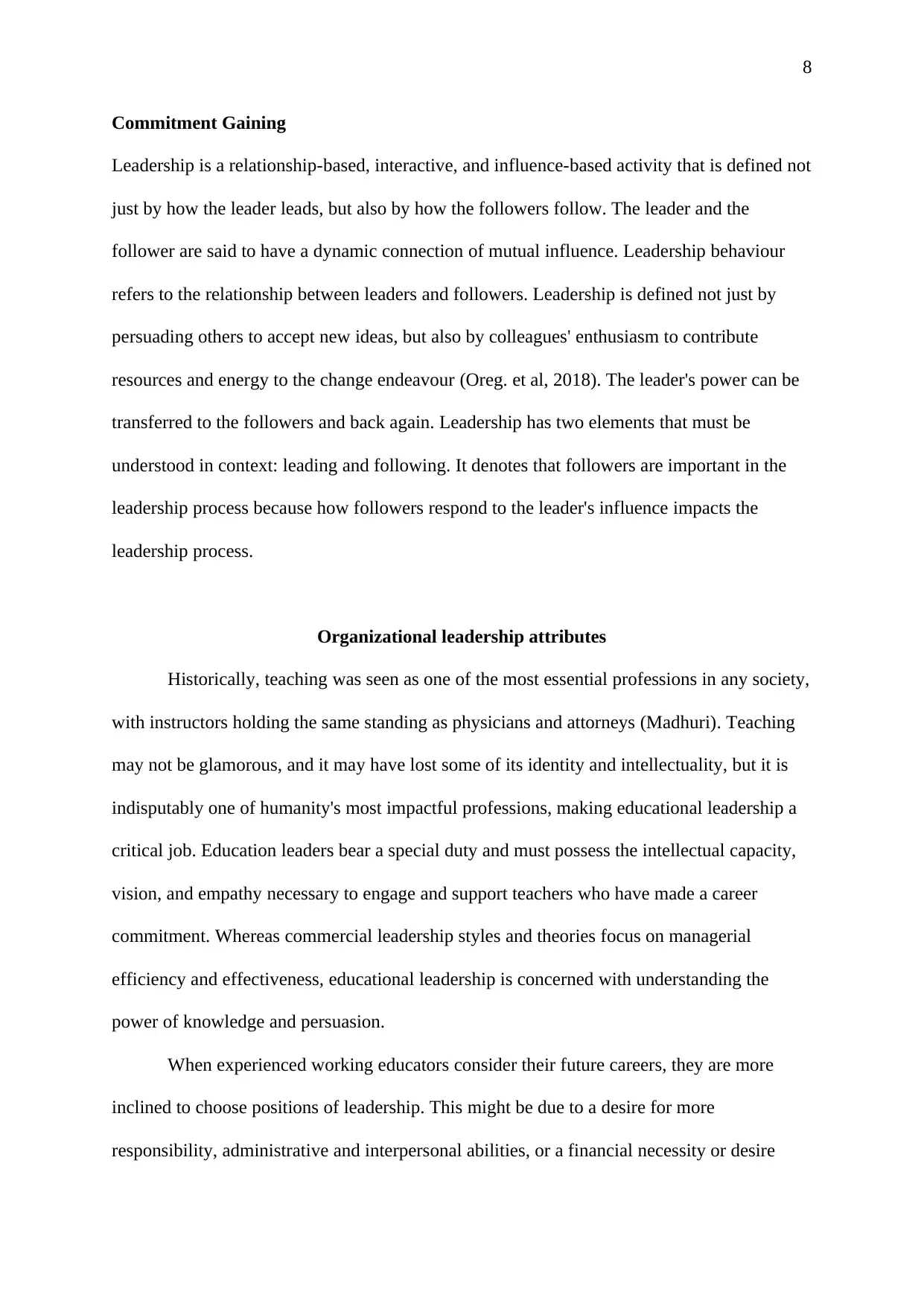
8
Commitment Gaining
Leadership is a relationship-based, interactive, and influence-based activity that is defined not
just by how the leader leads, but also by how the followers follow. The leader and the
follower are said to have a dynamic connection of mutual influence. Leadership behaviour
refers to the relationship between leaders and followers. Leadership is defined not just by
persuading others to accept new ideas, but also by colleagues' enthusiasm to contribute
resources and energy to the change endeavour (Oreg. et al, 2018). The leader's power can be
transferred to the followers and back again. Leadership has two elements that must be
understood in context: leading and following. It denotes that followers are important in the
leadership process because how followers respond to the leader's influence impacts the
leadership process.
Organizational leadership attributes
Historically, teaching was seen as one of the most essential professions in any society,
with instructors holding the same standing as physicians and attorneys (Madhuri). Teaching
may not be glamorous, and it may have lost some of its identity and intellectuality, but it is
indisputably one of humanity's most impactful professions, making educational leadership a
critical job. Education leaders bear a special duty and must possess the intellectual capacity,
vision, and empathy necessary to engage and support teachers who have made a career
commitment. Whereas commercial leadership styles and theories focus on managerial
efficiency and effectiveness, educational leadership is concerned with understanding the
power of knowledge and persuasion.
When experienced working educators consider their future careers, they are more
inclined to choose positions of leadership. This might be due to a desire for more
responsibility, administrative and interpersonal abilities, or a financial necessity or desire
Commitment Gaining
Leadership is a relationship-based, interactive, and influence-based activity that is defined not
just by how the leader leads, but also by how the followers follow. The leader and the
follower are said to have a dynamic connection of mutual influence. Leadership behaviour
refers to the relationship between leaders and followers. Leadership is defined not just by
persuading others to accept new ideas, but also by colleagues' enthusiasm to contribute
resources and energy to the change endeavour (Oreg. et al, 2018). The leader's power can be
transferred to the followers and back again. Leadership has two elements that must be
understood in context: leading and following. It denotes that followers are important in the
leadership process because how followers respond to the leader's influence impacts the
leadership process.
Organizational leadership attributes
Historically, teaching was seen as one of the most essential professions in any society,
with instructors holding the same standing as physicians and attorneys (Madhuri). Teaching
may not be glamorous, and it may have lost some of its identity and intellectuality, but it is
indisputably one of humanity's most impactful professions, making educational leadership a
critical job. Education leaders bear a special duty and must possess the intellectual capacity,
vision, and empathy necessary to engage and support teachers who have made a career
commitment. Whereas commercial leadership styles and theories focus on managerial
efficiency and effectiveness, educational leadership is concerned with understanding the
power of knowledge and persuasion.
When experienced working educators consider their future careers, they are more
inclined to choose positions of leadership. This might be due to a desire for more
responsibility, administrative and interpersonal abilities, or a financial necessity or desire
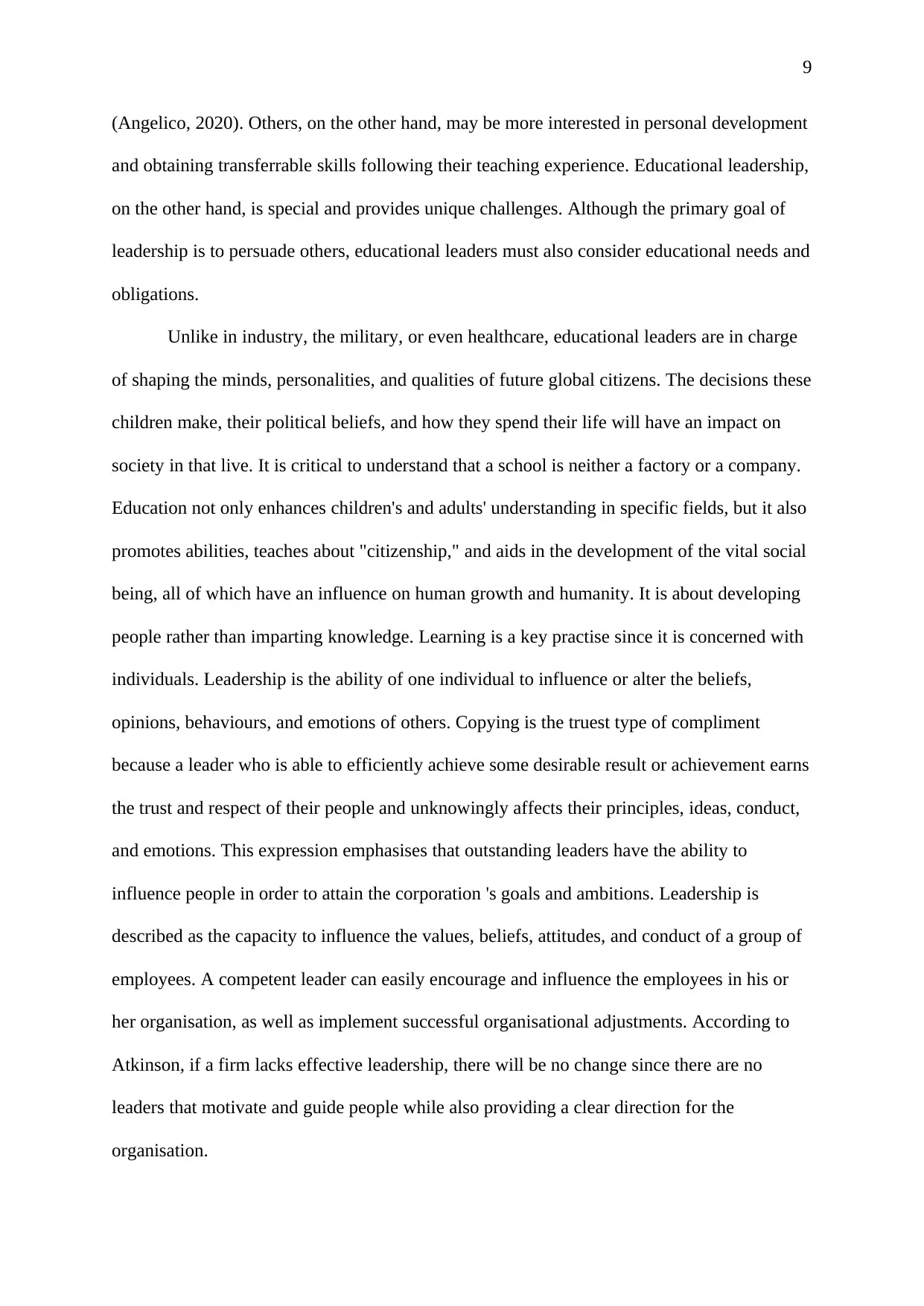
9
(Angelico, 2020). Others, on the other hand, may be more interested in personal development
and obtaining transferrable skills following their teaching experience. Educational leadership,
on the other hand, is special and provides unique challenges. Although the primary goal of
leadership is to persuade others, educational leaders must also consider educational needs and
obligations.
Unlike in industry, the military, or even healthcare, educational leaders are in charge
of shaping the minds, personalities, and qualities of future global citizens. The decisions these
children make, their political beliefs, and how they spend their life will have an impact on
society in that live. It is critical to understand that a school is neither a factory or a company.
Education not only enhances children's and adults' understanding in specific fields, but it also
promotes abilities, teaches about "citizenship," and aids in the development of the vital social
being, all of which have an influence on human growth and humanity. It is about developing
people rather than imparting knowledge. Learning is a key practise since it is concerned with
individuals. Leadership is the ability of one individual to influence or alter the beliefs,
opinions, behaviours, and emotions of others. Copying is the truest type of compliment
because a leader who is able to efficiently achieve some desirable result or achievement earns
the trust and respect of their people and unknowingly affects their principles, ideas, conduct,
and emotions. This expression emphasises that outstanding leaders have the ability to
influence people in order to attain the corporation 's goals and ambitions. Leadership is
described as the capacity to influence the values, beliefs, attitudes, and conduct of a group of
employees. A competent leader can easily encourage and influence the employees in his or
her organisation, as well as implement successful organisational adjustments. According to
Atkinson, if a firm lacks effective leadership, there will be no change since there are no
leaders that motivate and guide people while also providing a clear direction for the
organisation.
(Angelico, 2020). Others, on the other hand, may be more interested in personal development
and obtaining transferrable skills following their teaching experience. Educational leadership,
on the other hand, is special and provides unique challenges. Although the primary goal of
leadership is to persuade others, educational leaders must also consider educational needs and
obligations.
Unlike in industry, the military, or even healthcare, educational leaders are in charge
of shaping the minds, personalities, and qualities of future global citizens. The decisions these
children make, their political beliefs, and how they spend their life will have an impact on
society in that live. It is critical to understand that a school is neither a factory or a company.
Education not only enhances children's and adults' understanding in specific fields, but it also
promotes abilities, teaches about "citizenship," and aids in the development of the vital social
being, all of which have an influence on human growth and humanity. It is about developing
people rather than imparting knowledge. Learning is a key practise since it is concerned with
individuals. Leadership is the ability of one individual to influence or alter the beliefs,
opinions, behaviours, and emotions of others. Copying is the truest type of compliment
because a leader who is able to efficiently achieve some desirable result or achievement earns
the trust and respect of their people and unknowingly affects their principles, ideas, conduct,
and emotions. This expression emphasises that outstanding leaders have the ability to
influence people in order to attain the corporation 's goals and ambitions. Leadership is
described as the capacity to influence the values, beliefs, attitudes, and conduct of a group of
employees. A competent leader can easily encourage and influence the employees in his or
her organisation, as well as implement successful organisational adjustments. According to
Atkinson, if a firm lacks effective leadership, there will be no change since there are no
leaders that motivate and guide people while also providing a clear direction for the
organisation.
⊘ This is a preview!⊘
Do you want full access?
Subscribe today to unlock all pages.

Trusted by 1+ million students worldwide
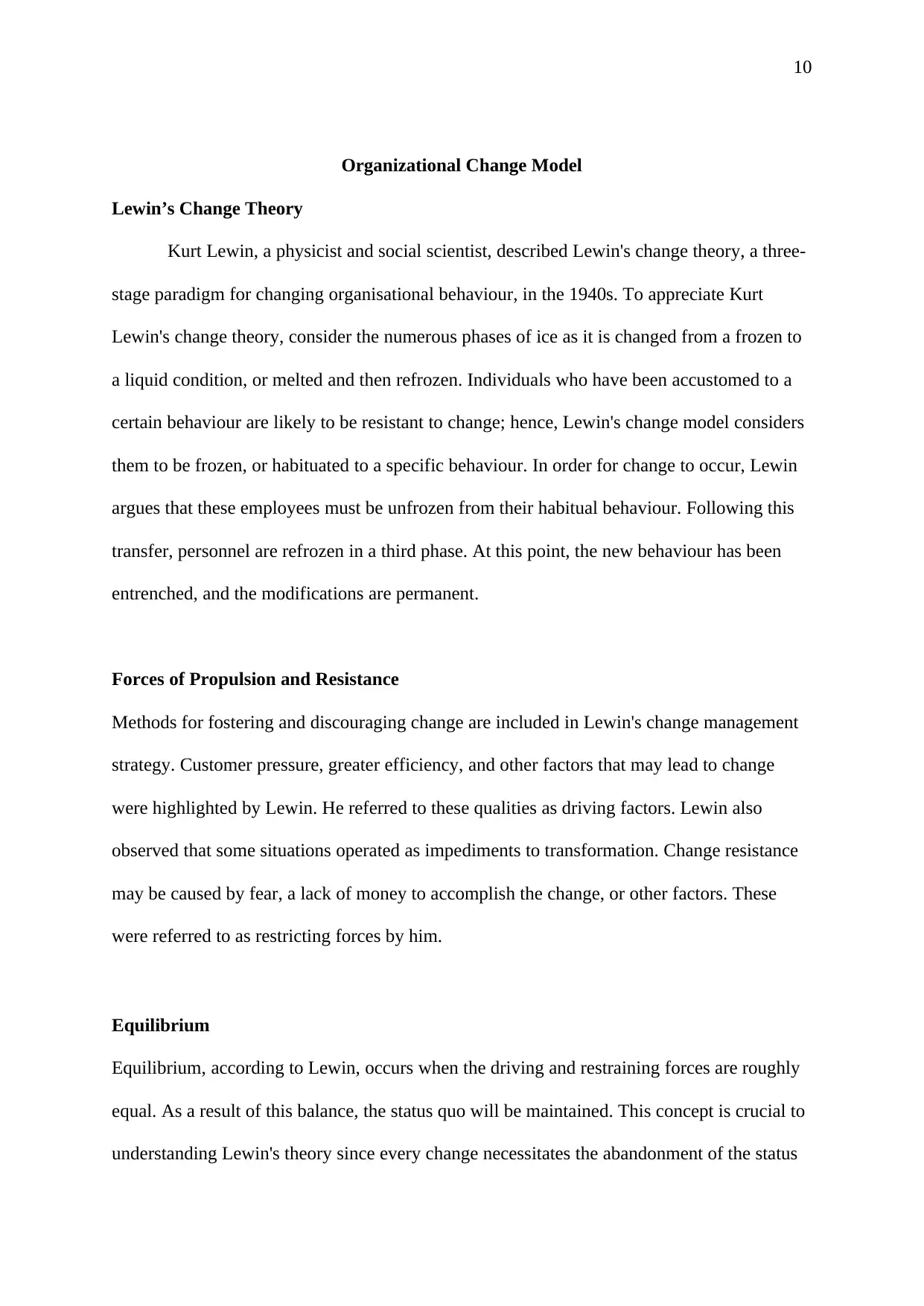
10
Organizational Change Model
Lewin’s Change Theory
Kurt Lewin, a physicist and social scientist, described Lewin's change theory, a three-
stage paradigm for changing organisational behaviour, in the 1940s. To appreciate Kurt
Lewin's change theory, consider the numerous phases of ice as it is changed from a frozen to
a liquid condition, or melted and then refrozen. Individuals who have been accustomed to a
certain behaviour are likely to be resistant to change; hence, Lewin's change model considers
them to be frozen, or habituated to a specific behaviour. In order for change to occur, Lewin
argues that these employees must be unfrozen from their habitual behaviour. Following this
transfer, personnel are refrozen in a third phase. At this point, the new behaviour has been
entrenched, and the modifications are permanent.
Forces of Propulsion and Resistance
Methods for fostering and discouraging change are included in Lewin's change management
strategy. Customer pressure, greater efficiency, and other factors that may lead to change
were highlighted by Lewin. He referred to these qualities as driving factors. Lewin also
observed that some situations operated as impediments to transformation. Change resistance
may be caused by fear, a lack of money to accomplish the change, or other factors. These
were referred to as restricting forces by him.
Equilibrium
Equilibrium, according to Lewin, occurs when the driving and restraining forces are roughly
equal. As a result of this balance, the status quo will be maintained. This concept is crucial to
understanding Lewin's theory since every change necessitates the abandonment of the status
Organizational Change Model
Lewin’s Change Theory
Kurt Lewin, a physicist and social scientist, described Lewin's change theory, a three-
stage paradigm for changing organisational behaviour, in the 1940s. To appreciate Kurt
Lewin's change theory, consider the numerous phases of ice as it is changed from a frozen to
a liquid condition, or melted and then refrozen. Individuals who have been accustomed to a
certain behaviour are likely to be resistant to change; hence, Lewin's change model considers
them to be frozen, or habituated to a specific behaviour. In order for change to occur, Lewin
argues that these employees must be unfrozen from their habitual behaviour. Following this
transfer, personnel are refrozen in a third phase. At this point, the new behaviour has been
entrenched, and the modifications are permanent.
Forces of Propulsion and Resistance
Methods for fostering and discouraging change are included in Lewin's change management
strategy. Customer pressure, greater efficiency, and other factors that may lead to change
were highlighted by Lewin. He referred to these qualities as driving factors. Lewin also
observed that some situations operated as impediments to transformation. Change resistance
may be caused by fear, a lack of money to accomplish the change, or other factors. These
were referred to as restricting forces by him.
Equilibrium
Equilibrium, according to Lewin, occurs when the driving and restraining forces are roughly
equal. As a result of this balance, the status quo will be maintained. This concept is crucial to
understanding Lewin's theory since every change necessitates the abandonment of the status
Paraphrase This Document
Need a fresh take? Get an instant paraphrase of this document with our AI Paraphraser
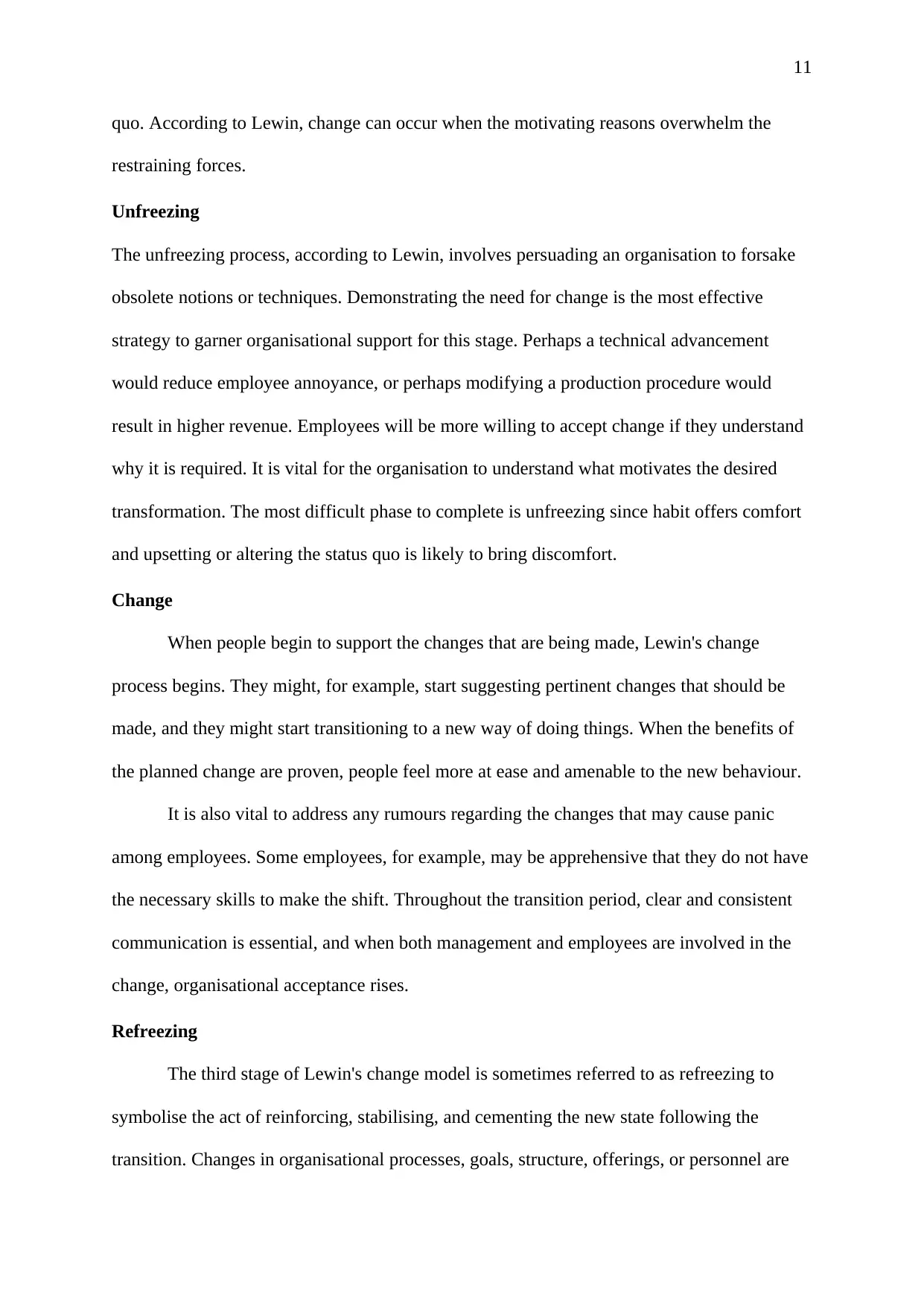
11
quo. According to Lewin, change can occur when the motivating reasons overwhelm the
restraining forces.
Unfreezing
The unfreezing process, according to Lewin, involves persuading an organisation to forsake
obsolete notions or techniques. Demonstrating the need for change is the most effective
strategy to garner organisational support for this stage. Perhaps a technical advancement
would reduce employee annoyance, or perhaps modifying a production procedure would
result in higher revenue. Employees will be more willing to accept change if they understand
why it is required. It is vital for the organisation to understand what motivates the desired
transformation. The most difficult phase to complete is unfreezing since habit offers comfort
and upsetting or altering the status quo is likely to bring discomfort.
Change
When people begin to support the changes that are being made, Lewin's change
process begins. They might, for example, start suggesting pertinent changes that should be
made, and they might start transitioning to a new way of doing things. When the benefits of
the planned change are proven, people feel more at ease and amenable to the new behaviour.
It is also vital to address any rumours regarding the changes that may cause panic
among employees. Some employees, for example, may be apprehensive that they do not have
the necessary skills to make the shift. Throughout the transition period, clear and consistent
communication is essential, and when both management and employees are involved in the
change, organisational acceptance rises.
Refreezing
The third stage of Lewin's change model is sometimes referred to as refreezing to
symbolise the act of reinforcing, stabilising, and cementing the new state following the
transition. Changes in organisational processes, goals, structure, offerings, or personnel are
quo. According to Lewin, change can occur when the motivating reasons overwhelm the
restraining forces.
Unfreezing
The unfreezing process, according to Lewin, involves persuading an organisation to forsake
obsolete notions or techniques. Demonstrating the need for change is the most effective
strategy to garner organisational support for this stage. Perhaps a technical advancement
would reduce employee annoyance, or perhaps modifying a production procedure would
result in higher revenue. Employees will be more willing to accept change if they understand
why it is required. It is vital for the organisation to understand what motivates the desired
transformation. The most difficult phase to complete is unfreezing since habit offers comfort
and upsetting or altering the status quo is likely to bring discomfort.
Change
When people begin to support the changes that are being made, Lewin's change
process begins. They might, for example, start suggesting pertinent changes that should be
made, and they might start transitioning to a new way of doing things. When the benefits of
the planned change are proven, people feel more at ease and amenable to the new behaviour.
It is also vital to address any rumours regarding the changes that may cause panic
among employees. Some employees, for example, may be apprehensive that they do not have
the necessary skills to make the shift. Throughout the transition period, clear and consistent
communication is essential, and when both management and employees are involved in the
change, organisational acceptance rises.
Refreezing
The third stage of Lewin's change model is sometimes referred to as refreezing to
symbolise the act of reinforcing, stabilising, and cementing the new state following the
transition. Changes in organisational processes, goals, structure, offerings, or personnel are
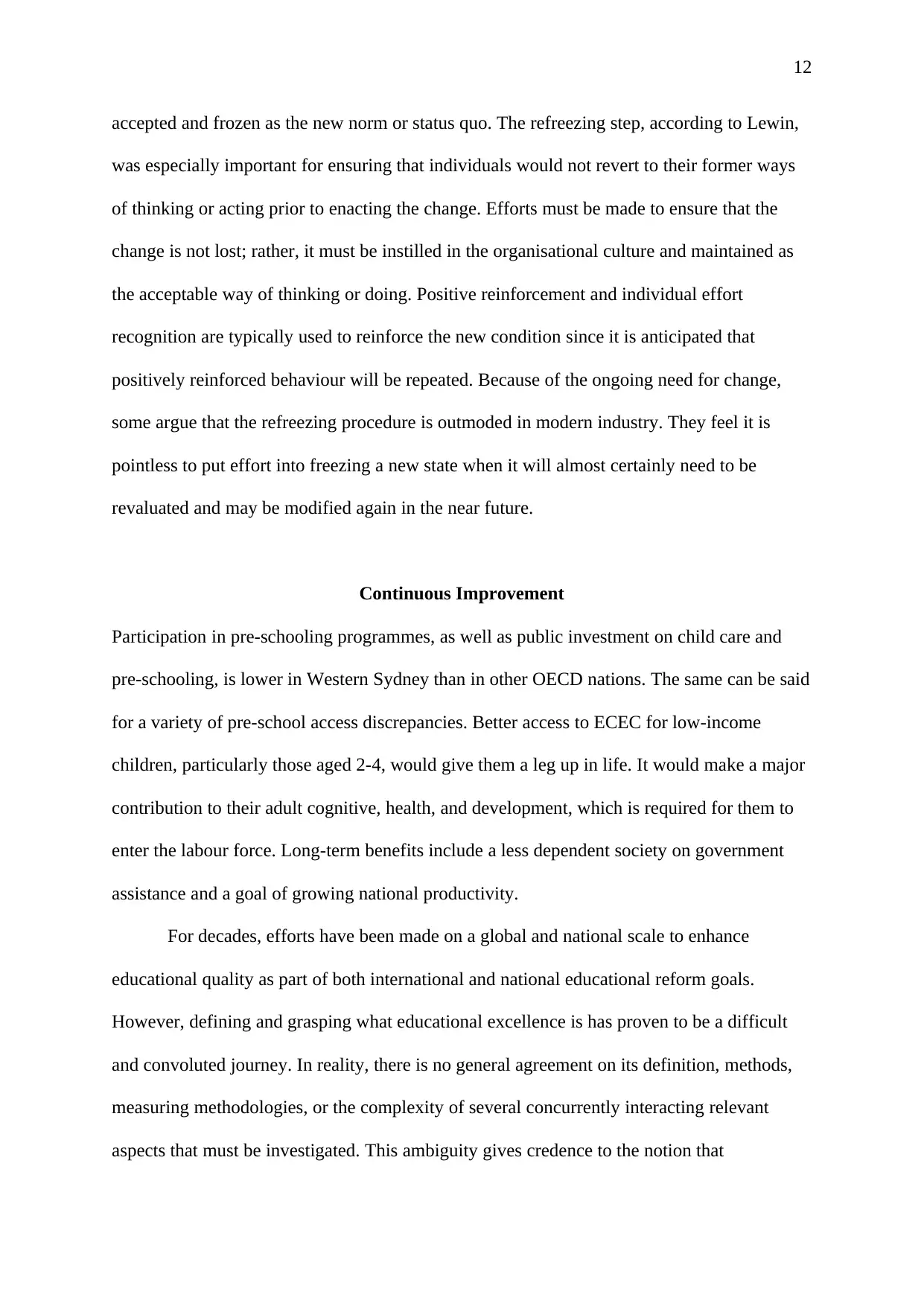
12
accepted and frozen as the new norm or status quo. The refreezing step, according to Lewin,
was especially important for ensuring that individuals would not revert to their former ways
of thinking or acting prior to enacting the change. Efforts must be made to ensure that the
change is not lost; rather, it must be instilled in the organisational culture and maintained as
the acceptable way of thinking or doing. Positive reinforcement and individual effort
recognition are typically used to reinforce the new condition since it is anticipated that
positively reinforced behaviour will be repeated. Because of the ongoing need for change,
some argue that the refreezing procedure is outmoded in modern industry. They feel it is
pointless to put effort into freezing a new state when it will almost certainly need to be
revaluated and may be modified again in the near future.
Continuous Improvement
Participation in pre-schooling programmes, as well as public investment on child care and
pre-schooling, is lower in Western Sydney than in other OECD nations. The same can be said
for a variety of pre-school access discrepancies. Better access to ECEC for low-income
children, particularly those aged 2-4, would give them a leg up in life. It would make a major
contribution to their adult cognitive, health, and development, which is required for them to
enter the labour force. Long-term benefits include a less dependent society on government
assistance and a goal of growing national productivity.
For decades, efforts have been made on a global and national scale to enhance
educational quality as part of both international and national educational reform goals.
However, defining and grasping what educational excellence is has proven to be a difficult
and convoluted journey. In reality, there is no general agreement on its definition, methods,
measuring methodologies, or the complexity of several concurrently interacting relevant
aspects that must be investigated. This ambiguity gives credence to the notion that
accepted and frozen as the new norm or status quo. The refreezing step, according to Lewin,
was especially important for ensuring that individuals would not revert to their former ways
of thinking or acting prior to enacting the change. Efforts must be made to ensure that the
change is not lost; rather, it must be instilled in the organisational culture and maintained as
the acceptable way of thinking or doing. Positive reinforcement and individual effort
recognition are typically used to reinforce the new condition since it is anticipated that
positively reinforced behaviour will be repeated. Because of the ongoing need for change,
some argue that the refreezing procedure is outmoded in modern industry. They feel it is
pointless to put effort into freezing a new state when it will almost certainly need to be
revaluated and may be modified again in the near future.
Continuous Improvement
Participation in pre-schooling programmes, as well as public investment on child care and
pre-schooling, is lower in Western Sydney than in other OECD nations. The same can be said
for a variety of pre-school access discrepancies. Better access to ECEC for low-income
children, particularly those aged 2-4, would give them a leg up in life. It would make a major
contribution to their adult cognitive, health, and development, which is required for them to
enter the labour force. Long-term benefits include a less dependent society on government
assistance and a goal of growing national productivity.
For decades, efforts have been made on a global and national scale to enhance
educational quality as part of both international and national educational reform goals.
However, defining and grasping what educational excellence is has proven to be a difficult
and convoluted journey. In reality, there is no general agreement on its definition, methods,
measuring methodologies, or the complexity of several concurrently interacting relevant
aspects that must be investigated. This ambiguity gives credence to the notion that
⊘ This is a preview!⊘
Do you want full access?
Subscribe today to unlock all pages.

Trusted by 1+ million students worldwide
1 out of 20
Related Documents
Your All-in-One AI-Powered Toolkit for Academic Success.
+13062052269
info@desklib.com
Available 24*7 on WhatsApp / Email
![[object Object]](/_next/static/media/star-bottom.7253800d.svg)
Unlock your academic potential
Copyright © 2020–2025 A2Z Services. All Rights Reserved. Developed and managed by ZUCOL.




